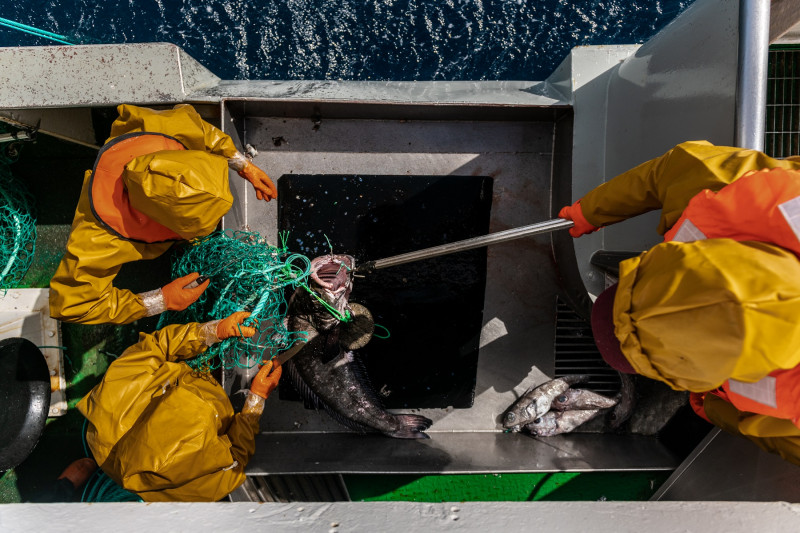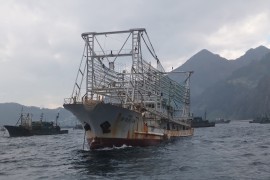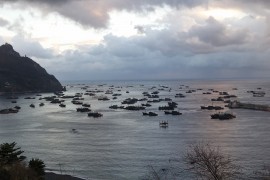English version
China’s global fishing dominance
Subsidies have grown the Chinese fishing fleet into a global force of unprecedented size and geographic reach. This situation has led to international conflicts
Ian Urbina 18/10/2020

Aerial shot of the crew catching fish (January 2019, Antarctica).
Fabio NascimentoEn CTXT podemos mantener nuestra radical independencia gracias a que las suscripciones suponen el 70% de los ingresos. No aceptamos “noticias” patrocinadas y apenas tenemos publicidad. Si puedes apoyarnos desde 3 euros mensuales, suscribete aquí
More than a hundred miles from shore, near the coast of West Africa, I accompanied marine police officers from Gambia as they arrested 15 foreign ships for labor violations and illegal fishing over the course of a week in 2019. All but one of the vessels arrested were from China.
At the beginning of that same year, during a month-long voyage on a toothfish longliner headed into Antarctic waters from Punta Arenas, Chile, the only other ships we passed were a dozen rusty Chinese purse seiners that looked barely seaworthy.
La pandemia ha golpeado duro a CTXT. Si puedes, haz una donación aquí o suscríbete aquí
Aboard a South Korean squid boat in May 2019, I watched nearly two dozen ships flying Chinese flags make their way single file into North Korean waters, in flagrant violation of United Nations sanctions. They were part of the world's largest fleet of illegal ships: 800 Chinese trawlers fishing in the Sea of Japan, revealed in a recent investigation for NBC.
And this month, more than 340 Chinese fishing vessels appeared just outside the biodiverse and ecologically sensitive Galápagos Marine Reserve. Many of the ships were tied to companies associated with illegal fishing, according to C4ADS, a conflict research firm. Three years prior, a similarly-sized Chinese flotilla arrived in these same waters, and one ship was apprehended with about 300 tons of illegally caught fish, including endangered species, such as scalloped hammerhead sharks.
With anywhere from 200,000 to 800,000 boats, some as far afield as Argentina, China is unmatched in the size and reach of its fishing armada. Fueled primarily by government subsidies, its growth and activities have largely gone unchecked, in part because China itself had historically had few rules governing fishing operations. The dominance and global ubiquity of this fleet raise broader questions about how, why, and at what cost China has put so many boats on the water.
The why has long been clear: geopolitical power and food security for China’s 1.4 billion people. As the U.S. Navy has pulled back from the waters of West Africa and the Middle East, China has bolstered its fishing and naval presence. And in places such as the South China Sea and the Arctic’s Northern Sea Route, China has laid claim to prized shipping lanes as well as sub-sea oil and gas deposits.
Already 90 percent of commercial fish stocks tracked by the U.N.’s Food and Agriculture Organization have been overfished or fully fished
“The scale and aggressiveness of its fleet puts China in control,” says Greg Poling, director of the Asia Maritime Transparency Initiative at the Center for Strategic and International Studies, adding that few foreign countries have been willing to push back when China’s fishing boats make incursions into their national waters.
As for food security, many of the marine stocks closest to China’s shores have dwindled from overfishing and industrialization, so ships are forced to venture farther to fill their nets. The Chinese government says it has roughly 2,600 distant-water fishing vessels, which, according to a recent report by the Stimson Center, a security research group, makes it three times larger than the fleets of the next top four countries—Taiwan, Japan, South Korea, and Spain—combined.
“Without its massive subsidy schemes, China’s distant water fishing fleet would be a fraction of its current size, and most of its South China Sea fleet wouldn’t exist at all,” Poling says.
Over the past two decades, China has spent billions of dollars supporting its fishing industry, says Tabitha Grace Mallory, a professor at the University of Washington, who specializes in China’s fishing policies, in email. In 2018, total global fisheries subsidies were estimated to be $35.4 billion, with China accounting for $7.2 billion of it. The vast majority of that amount went toward what Mallory calls “harmful” subsidies, because they expand rather than contract the size of fishing fleets. This includes those for fuel and for new boats that increase the size of the fleet. Alternatively, a small portion of states subsidies pay for the decommissioning of boats, according to Mallory.
The government also helps cover the cost of new engines, of more durable steel hulls for trawlers, and for armed security and medical ships to be stationed at fishing grounds, enabling fishing captains to stay at sea for longer. Chinese fishermen further benefit from government-led fishing intelligence that helps them find the richest waters.
Daniel Pauly, principal investigator of the Sea Around Us Project at the University of British Columbia’s Institute for the Oceans and Fisheries, explained in email that subsidies have not only increased geopolitical tensions by allowing ships to venture into contested regions.
Pauly said, “They also play a major role in depleting fish stocks as they keep vessels operating that would otherwise be decommissioned."
As long as fleets are provided financial assistance to overfish, experts say that sustainable fishing is impossible. Already 90 percent of commercial fish stocks tracked by the U.N.’s Food and Agriculture Organization have been overfished or fully fished—meaning they are past their capacity to sustainably replenish themselves—including the world’s 10 most important commercial species.
Government-funded overfishing
China is by no means singular when it comes to subsidizing its fishing fleet. More than half of the global fishing industry would be unprofitable at its current scale without government subsidies, according to a 2018 study in Science Advances led by National Geographic Society Explorer-in-Residence Enric Sala.
Japan spends more in subsidies for fishing on the high seas—the parts of the ocean not under control by any government—than any other country, accounting for about 20 percent of global high seas fishing subsidies—$841 million, Sala’s study shows. Spain accounts for 14 percent of global fishing subsidies, followed by China at 10 percent, then South Korea, and the U.S.
But when it comes to scale, China is by far the biggest. With more than 800 ships on the high seas, Chinese vessels were responsible for more than 35 percent of the reported global catch on the high seas in 2014—more than any other country. (Taiwan, with the next highest number of vessels at 593, accounts for about 12 percent of that catch, and Japan, with 478 ships accounts for less than 5 percent.)
But subsidies are not just a major reason that the oceans are rapidly running out of fish. In putting too many vessels on the water globally, subsidies can lead to fishing over-capacity, unhealthy competition, territorial disputes, and illegal fishing as captains become desperate to find new, less-crowded fishing grounds.
Spain accounts for 14 percent of global fishing subsidies, followed by China at 10 percent, then South Korea, and the U.S.
“To put it bluntly, this is akin to paying burglars to rob your neighbor’s house,” says Peter Thomson, the U.N. Secretary-General’s Special Envoy for the Ocean, about the role that subsidies play in encouraging illegal fishing.
China ranks as having the world’s worst score when it comes to illegal, unreported, and unregulated fishing, according to an index published last year by Poseidon Aquatic Resource Management, a fishery and aquaculture consulting firm.
Small changes
Still, China is showing small signs of improvement. Responding to international pressure from ocean conservation groups and foreign governments, the government has begun to tighten control on its fleet in recent years, but conservationists and fisheries experts remain skeptical.
In 2016, the government released a five-year plan to cap the number of distant-water fishing vessels to fewer than 3,000 by 2021. It’s unclear whether China has made any progress toward this goal, however, because the government releases little data on ship numbers.
And in June, the Chinese fishing authorities announced they will close squid-catching seasons for Chinese boats in certain South American waters from July to November, citing the need to allow squid populations to replenish. This is the first time China has ever voluntarily closed a fishing season.
“I believe that the Chinese government is serious when they offer to restrict their distant water fleet,” Pauly says. “Whether they can enforce the planned restrictions onto their fleet is another question; indeed, I don’t believe they control their distant-water fleets any more than we control ours in the West.”
With a rapidly growing middle class that’s able to afford more seafood, the Chinese government has boosted its aquaculture industry with more than $250 million in subsidies between 2015 and 2019 in an effort to reduce the country’s dependence on wild-caught fish.
That move, however, presents a new problem: To fatten up their fish, most fish farms rely on fishmeal, a high-protein powder predominantly made from wild-caught fish from foreign or international waters. Furthermore, aquaculture takes a lot of fishmeal—before a farmed tuna gets to market, for example, it may eat more than 15 times its weight in wild fish in the form of fishmeal.
Ocean conservationists warn that the voracious nature of fishmeal production is accelerating ocean depletion, contributing to illegal fishing, destabilizing the aquatic food chain, and sapping poorer countries’ waters of protein sources needed for local subsistence.
“Catching large amounts of wild fish to feed a growing demand for farmed fish makes little sense,” Sala says. “A fraction of those wild fish could instead be used to feed people directly, with less impact on ocean life.”
To meet the demand for fishmeal and fish oil, Chinese fishing authorities said in 2015 they planned to increase the amount of krill harvested from Antarctic waters from 32,000 metric tons to two million metric tons, though they committed to staying out of “ecologically vulnerable” areas. Krill are a primary food source for whales, and conservationists worry about the knock-on effects of such a high harvest.
Subsidies’ role in destabilizing international relations
In addition to the potentially devastating environmental consequences of overfishing and fisheries collapses, so many ships on the sea means more competition for fishing grounds, which can destabilize relationships between countries and lead to violent clashes.
In 2016, the South Korean Coast Guard opened fire on two Chinese fishing vessels that had threatened to ram patrol boats in the Yellow Sea. A month earlier, Chinese fishermen rammed and sank another South Korean speedboat in the same area. In the same year, Argentina sank a Chinese boat it claimed was fishing illegally in its waters. Indonesia, South Africa and the Philippines have all had recent run-ins with Chinese fishing fleets. In most of these cases, the Chinese boats were fishing for squid, which represents more than half of the fleet's catch on the high seas.
One of the reasons China’s fleet is so bloated is that some of its fishing ships serve purposes other than merely fishing. Part of a so-called “civilian militia,” Poling says, these fishing vessels are dispatched to conflict zones at sea to surveil the waters and occasionally to intimidate and ram fishing or law enforcement boats from other countries. Separate from its subsidies program that supports its distant-water fishing fleet, China has a program that incentivizes boats to operate in disputed waters in the South China Sea as a way to assert China’s claims. They get many of the same benefits as the distant water fleet, plus cash payments because operating in that region is otherwise unprofitable.
More than 200 of these militia fishing boats occupy the waters around the South China Sea’s disputed Spratly Islands—an area rich with fish, and possibly oil and natural gas too—to which China, the Philippines, Vietnam, and Taiwan lay claim. Satellite imagery shows that the Chinese fishing boats in the area spend most of their time anchored close together in clusters and are not actually fishing.
“The only reason that smaller [Chinese] fishermen go out to the Spratlys is because they’re paid to do so,” Poling says. The presence of these fishing vessels has sped the decline of fish around the islands, led to clashes with fishing boats from other countries, and given China cover to build military installations on some of the reefs, further reinforcing its claims to the territory.
Bolstered by subsidies, the Chinese fleet is not only the world’s largest it is also larger than previously recognized. Similarly, the recent discovery of the nearly 800 Chinese trawlers fishing illegally in North Korean waters offers new insight into the disappearance of more than 70 percent of the squid stock in the Sea of Japan (also known as the East Sea).
In sending a previously invisible armada of industrial boats to fish in these banned waters, China has been violently displacing smaller North Korean vessels and spearheading a decline in once-abundant squid stocks. Asked about the findings, documented by novel satellite technology from Global Fishing Watch and confirmed by my 2019 excursion on a South Korean squid boat, the Chinese Ministry of Foreign Affairs said in a statement to NBC that it “conscientiously enforced” the U.N. Security Council’s North Korea resolutions and has “consistently punished” illegal fishing, but it neither confirmed nor denied the presence of Chinese ships there.
‘They are very serious’
Partly because they travel in groups and sometimes with armed security, Chinese fishing ships are often aggressive toward competitors or perceived threats. I saw this up close after paying my way onto a South Korean squid ship and heading offshore in the Sea of Japan where I hoped to document the presence of illegal Chinese squidders.
Our captain was a short and wiry man, roughly 70 years old, with deep-set eyes and skin weathered like an elephant. On the morning of our scheduled departure, the hired crew told the captain that they would not be working the trip. They said they were too nervous about being associated with any reporting related to North Korea and about getting near Chinese fishing ships.
The captain said we could still go to sea with just his first mate, but the ship would be tough to manage, dirtier than normal, and we would need to help him when asked.
Stinking of rotten chum and skating-rink slippery from prior catch, the deck of the 60-foot long wooden vessel was a mess. Crew quarters were trashed, and the ship engine conked out on us several hundred miles from shore, leading to a tense two hours until it was fixed.
Shortly after nightfall on our very first day offshore, the blip of a boat appeared on our radar. We raced to catch up with what turned out to be not just one ship but nearly two dozen, all heading single-file from South Korean waters into North Korean waters. All were flying Chinese flags, and none with their transponders turned on, as required in South Korean waters.
We followed the boats, filmed them, documented their identification numbers, and after about 45 minutes, we put a drone in the air to get a better look at the ships. In response, one of the Chinese boat captains blared his horn, flashed his lights, and then abruptly cut toward us in a ramming maneuver—a warning. We stayed our course, but the Chinese ship continued toward us. When it reached within 30 feet of us, we suddenly veered to avoid collision.
This was as much as our captain wanted to risk. Deciding it was too dangerous to continue, he turned our ship around and began the eight-hour trip back to port, during which he seemed unusually quiet and slightly rattled. “They are very serious,” he kept murmuring, referring to the Chinese fishermen, who, undaunted, continued heading into North Korean waters.
Clearly, subsidies had not just grown the Chinese fishing fleet into a global force of unprecedented size and geographic reach. They had also instilled a sense of ambition, drive and boldness that few other countries or their fishing captains were willing or able to challenge.
La pandemia ha golpeado duro a CTXT. Si puedes, haz una donación aquí o suscríbete aquí
More than a hundred miles from shore, near the coast of West Africa, I accompanied marine police officers from Gambia as they arrested 15 foreign ships for labor violations and illegal fishing over the course of a week in 2019. All but one of the vessels arrested were from China.
At the beginning of that...
Autor >
Ian Urbina
Ian Urbina es exreportero de investigación del New York Times y director de The Outlaw Ocean Project, una organización de periodismo sin fines de lucro con sede en Washington, D.C., que se enfoca en informar sobre crímenes ambientales y de derechos humanos en el mar.
Suscríbete a CTXT
Orgullosas
de llegar tarde
a las últimas noticias
Gracias a tu suscripción podemos ejercer un periodismo público y en libertad.
¿Quieres suscribirte a CTXT por solo 6 euros al mes? Pulsa aquí






